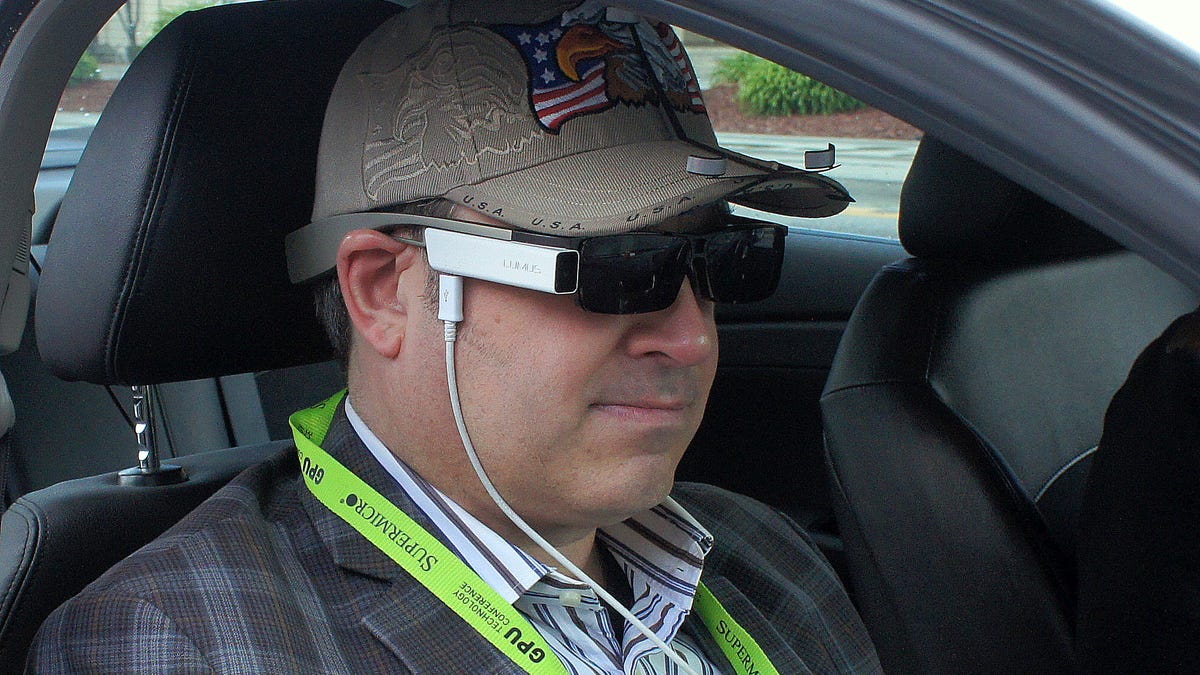Smart glasses show the road to take
During a demonstration at Nvidia's GTC developer conference, Mishor showed off augmented reality navigation on a pair of smart glasses.

Correction: This article originally said Mishor had a partnership with Harman. Mishor's partner for a production HUD is Bosch.
SAN JOSE -- At the Nvidia GTC developer conference this week, I found myself wearing a pair of Lumus high tech projection glasses and a dorky hat, being driven around and around the convention center by Kobi Ben Tzvi, CEO of a company named Mishor. While any bystander would assume I was being pranked, I was actually viewing augmented reality navigation instructions.
In 80 percent translucent graphics in my right eye's field of vision, I could see blue path indicators laid over the road, showing me where we should turn. For upcoming maneuvers and destinations, the projection showed me a distance indicator.
More impressive, as I moved my head to look at the surroundings, the navigation graphic maintained its position on the roadway.
At least, this projected navigation system worked like that part of the time. Mishor, the company that built this project, showed me a very early development version that still need a lot of development and refinement. As I moved my head, sometimes the graphics would disappear as the head-tracking hardware lost its calibration.
This project consists of Mishor's head-up-display software, navigation running on an iPhone, and a pair of Lumus' projection glasses. These glasses go beyond Google's Glass project, using multiple beam splitters that can overlay graphics on the outside world and use motion technology to hold the position of those graphics relative to the outside world. CNET editor Jessica Dolcourt got a detailed look at Lumus' DK40 glasses during CES.
Mishor develops head-up-display software in a product it calls ShadowBox. Through a partnership with Bosch, Mishor's software will come into a production car later this year. A demonstration on Mishor's Web site shows how ShadowBox can indicate turn-by-turn directions, overlaying the path on the road, and will also alert the driver to pedestrians, again with projections on the windshield.
Porting ShadowBox to an application on Lumus glasses is much more challenging, as my head was moving around irrespective of the car, whereas the windshield wasn't. To enable head tracking for this project, Mishor put reflectors on the visor of a hat, so an in-car camera could track where I was looking.
From my talks with the Mishor CEO and CTO, the final version won't need that sort of extra gear. The finished project should merely require a set of glasses connected wirelessly to a smartphone.
As for navigation, this system could be an impressive breakthrough. Current navigation, showing turn-by-turn directions on a smartphone, dashboard LCD, or even a head-up-display, are fine for simple upcoming turns, but are not as informative for complex intersections with multiple roads going off in similar directions. Mishor is developing a route guidance graphic that can show you exactly the lane you need to be in and the turn you need to take, overlaid on the road.
During my demo drive, I was certainly distracted as I was looking for the graphics. But when I settled back and looked at the road ahead, I did not find the turn graphics got in the way at all. The projection is subtle, putting a translucent stripe down the middle of the lane.
However, unless smart glasses become a part of daily wear, I don't see a system like this taking off for drivers. Augmented reality applications already look ready to come to production car windshields, providing helpful information such as turn directions and street names. I can't see drivers putting on a special pair of glasses whenever they get in a car. It is kind of like the 3D television revolution that never was.

